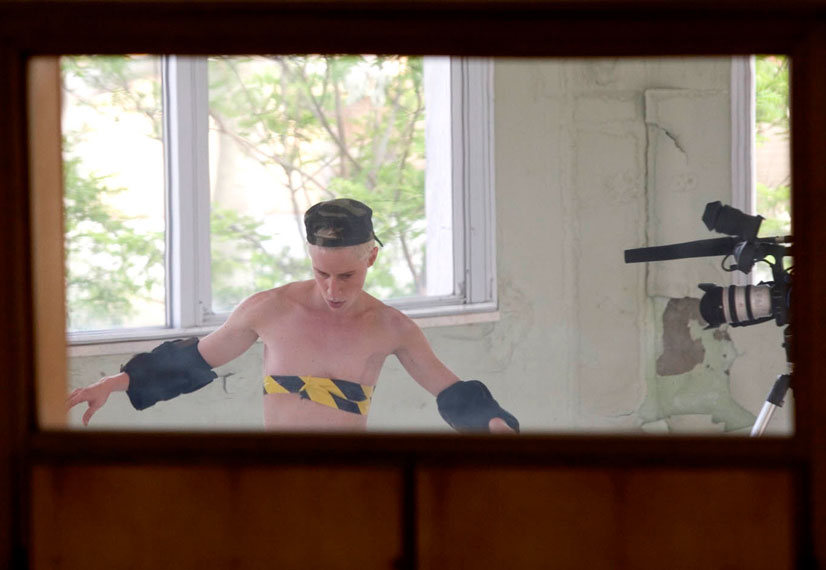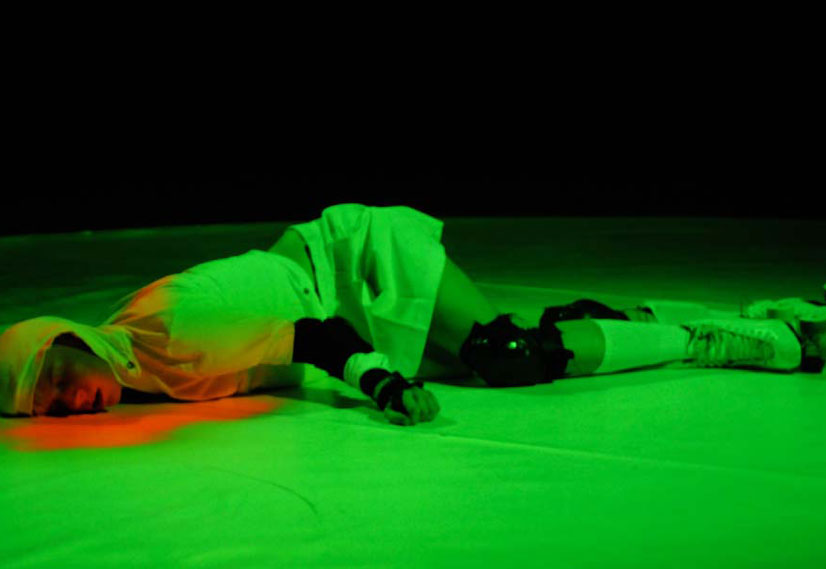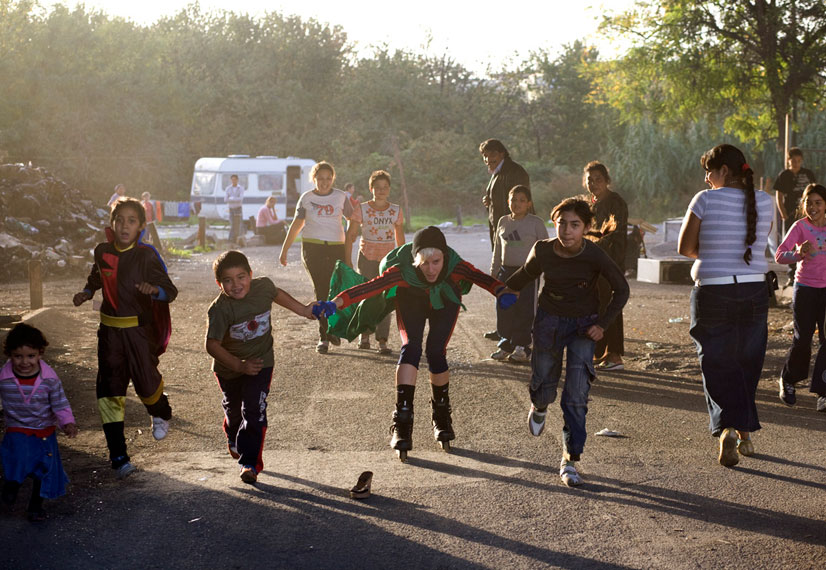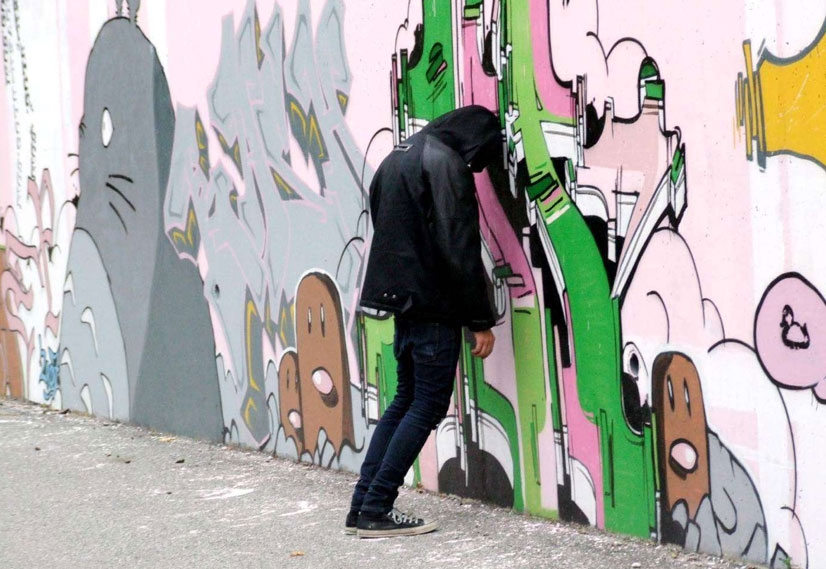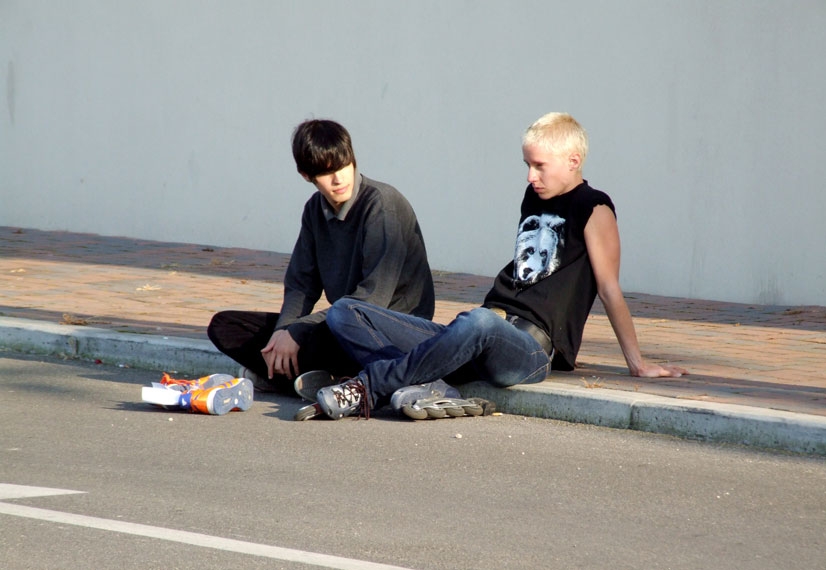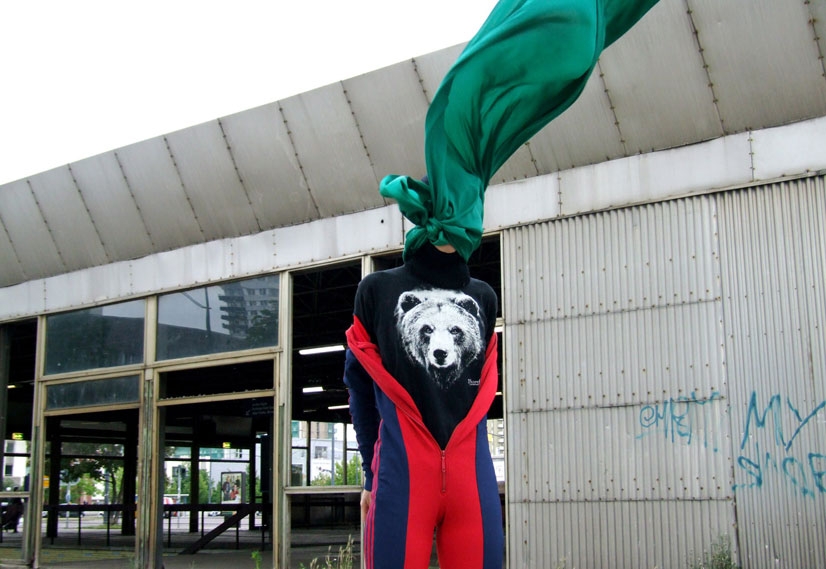
©End-Dna
Of X (ICS) Racconti crudeli della giovinezza are part:
Sidewalk
A pavement as ultimate support for our theatre, as a tired barrier between us and the world. Now our actors are leaning there and waiting there. Opposite a bench and separated by a street. Fractals of a frayed environment held together by Sellotape.
Little remains, a few scattered things, a sleeping bag, a camping lamp, a twig and lots of empty cardboard boxes. Little remains and there’s a desire for little, for being increasingly less outside, exposed, rowdy, shouting, noisy.
In the reigning vulgarity there’s a need for timidity, indecision, slowness; for being in the open air without protection, unarmed. And it is not a surrender. When the territory is shattered and non-commitment advances, political and cultural arrogance crosses worrying thresholds: those who govern are the ones who raise their voices and offend, who employ jokes and obscenities, who wish the recourse to the iron hand, to zero tolerance.
Disturbing ghosts of the past regime step forward…they proceed from beneath, from below, acting on taste and the approach to doing… they insinuate themselves everywhere, also among the red seats of the old “Italian style” theatres where, no accident, centre stage is still taken by ham actors, talkers, egocentric fabulists, with repertory shows in which even transgression is sweetened or ridiculed in order to elicit a fierce grin…
What governs is the taste of those who dispense tranquillisers or escapist illusions, false and recycled American dreams… We certainly do not govern, nor do we want to occupy certain chairs. Better to be outside, far from the centres and from the sport-show mobs: we’re where it’s better not to be, where you don’t know what might happen. On the pavement, in the way. We aren’t background, we simply are.
We look at youth as a metaphor of uncertainty and transformation. Not number of years but interior youth, attitude and willingness to be invaded by events, curiosity towards the non-certain, the non-defined, the non-reducible to purely economic-utilitarian terms.
And it isn’t a nostalgic expedient but a practice of detoxification. We sit on the edge of the thoroughfare, the boundary between pedestrians and cars, breathing “fresh air and exhaust fumes, fresh air and alcoholic designer perfumes, fresh air and words tossed into the shredder… all that comes to me are pieces of world, pieces of faces, of cars, motorbikes, of dogs, of children, of windows, of doors, of cafés, blocks of flats… pieces of howls and cries, of telephone and electrical cables, pieces of neon signs, of torn posters, of writings, graffiti and faded obscenities, cigarette ends and fragments of crockery, pieces of windscreens and old shoes, and again, always the same and different, pieces of a world that’s going to pieces…”. Excerpt from the text for the show X(ics) Cruel tales of youth.
Or we go outwards, thrust by irremediably centripetal force, towards nameless places. Why are we still attracted by abandoned buildings? For their form of vagueness? Of non-form? Evidently even the absence of form is form. It’s the reverse of urban places, residue of cities. There’s a strange similarity between youth and terrains vagues: in Italian town-planning these spaces are called “white zones”, places produced by the progressive building-up – not always authorised – of zones that lie outside the town-planning scheme. The white differentiates them both from the built-up area and the natural, the latter completely produced by culture, the so called public green areas of parks and gardens. This “vague” space, meaning white, is characterised on the basis of the singularity of absence, absence of colour and of recognisable features: the ideal scenario for unpredictable actions, clandestine meetings, bloodshed, promiscuous encounters and dangerous games… everything that lies at the boundary-margin of the quiet life (unfortunately both good and ill…).
The glance in these spaces is close, panting: when you walk on uneven terrain you can’t look up or into the distance, you have to scrutinise the terrain, check for ups and downs and potentially dangerous materials. It’s an eye that lingers, syntax of a body that touches, explores detail, feels the masses, the roughness… We like to think of a motory-knowledge rather than a visual one, a wisdom-knowledge that enters into the pores of the objects, scrutinises them, sections them into their constitutive pixels. The matrix that veils the images in Ics is to some extent this glance, where micro-macro are fused in an attempt to go increasingly deeper into things in accordance with a “radical incorporation”. It’s an advancing by unpredictable sensorial focalisations where sight, touch and smell are constantlyactivated, balance is precarious, the itinerary unknown, but we proceed, integrating tracking shots one after the other of partial world visions, the disintegrated pieces of a whole which is “falling to pieces”… In the case of both buildings-rubble and urban vacuums, the fascination of interstitial places lies in their very irreducibility, in their subtle and fleeting diffusion… a vacuum of opposition to urban fullness, a vacuum of opposition also to adult fullness.
They are the spaces of the uncultivated, of random proliferation, of unexpected grafting, of imaginative brassage among species that have escaped the control of the gardeners and cultivators of the urban order.
Contexts that we like to compare to the “resistant” theatre that we insist on doing, climbing-theatres, invasive, which first of all colonise all our living experience and then propagate to the existences of others, of those who work with us or see us in an alive way, not as drowsy spectators.
Vegetation invades, transforms, insinuates itself into what has lost usefulness and reason, finding a source of life and expansion in emptiness, among the pieces of what no longer exists… wild vegetation that only reinforced concrete can extirpate? It depends, it’s only a question of time and atmospheric alchemies. There are plants that grow in the cracks of the hardest cement and split it… roots that deform pavements, tear up cobblestones with patient tenacity. Pyrophyte plants which proliferate where there have been fires, which are fire resistant (passive pyrophytes)or which regenerate as a result of fire (active pyrophytes) in effect find vital energy in destruction itself… And destruction is under way in this fine anaesthetised country. At this point, expelled and purposely non belligerent, we feel it’s time to get to the end, to the fire, to the tabula rasa of saying and doing, in order to find new forms of existing. We have years of heavy training behind us in transformation, flexibility, in getting by even with little or nothing, in the corners, against.
We expect the worst in order to be reborn from the worst. Trusting.
(Daniela Nicolò)
X (ics) Racconti crudeli della giovinezza
From the Outskirts of the Theatre
Motus is a Latin word meaning movement, and the idea of movement has framed the whole of our activity: both for the ongoing, almost obsessive need to seek and challenge different expressive formats and for the nomadic dimension that our projects have taken on from time to time. Behind each new theatre itinerary – towards the universe of an artist or of a specific theme – there is always a foray of reconnaissance, study and gathering of materials in the world of things. Io vivo nelle cose (I live in things) is also the title of our latest book, published by Ubulibri in Milan with the subtitle Appunti di viaggio da Rooms a Pasolini (Travel Notes from Rooms to Pasolini)… This frantic research came up against tragic and desperate artists, tackled as universes and sources, as experience of life and “politics”: DeLillo, Genet, Pasolini, Fassbinder…
(…) But “theatre” never springs from the theatre, just as “art” does not spring from art alone. The prime mover that impels Motus on its now more than ten year journey is always a need and a solicitation of “reality”. Motus lives our times with breathlessness and lightness, knows how to skate the surface of the contemporary, but is always ready to plunge into the depths, to penetrate the places where the wounds and contradictions of the human are manifested. (Rodolfo Sacchettini).
If the theme of the journey has always been a constant – deserts and American motels for the Rooms trilogy – the inquiry into the suburbs of great metropolises was delineated at the time of research on Pasolini.
In particular Like a dog without a master (2003), a work inspired by Oil, marked a new phase of documentary study in the suburbs, seeking testimony and denunciations from the various and complex social situations found there.
This performance originated with a journey to the suburbs of Naples and Rome in a camper van equipe with three film cameras on the windscreen that synchronically shot the desolate cityscapes described by Pasolini thirty years earlier, filming the changes they had or had not undergone. In our encounters at gipsy camps and with kids accustomed to playing among the rubbish and debris of a city centre that was “cosmetically” distant from them, we got the idea of continuing our inquiry to include young people from Italian and foreign suburbs. The subsequent project, dedicated to Fassbinder and begun in 2005, was also accompanied by a video-installation called Little Episodes ofEveryday Fascism, made up of dozens upon dozens of video-stories by young people met during workshops held in Italy, France and Belgium.
Youth and suburbs: why has this theme attracted us for years and led us to continual research and in-depth study? Maybe it’s simply because our theatre itself grew out of small rehearsal rooms in the suburbs, in places forgotten by the local administrations, old run-down industrial premises awaiting demolition or renovation. Always in the provinces, always away from big centres: we moved to the limits, to the estreme boundaries between town and country. And it was precisely on this territory undergoing transformation that we found the necessary freedom from time schedules, market demands and expectations to build, with discorde and recycled materials, our parallel and often delirious worlds.
Today there is no way we can talk about suburbs in a broad sense. In general we are talking about a vast metropolitan area, often associated with aesthetic and formal degradation, buildings without qualities, inadequate services, and then comparing it with a real centre that bears historical signs and traditions.
Many city centres today are increasingly unliveable because tourists have divided them into lots, sucked their blood and Disneylandized them.
The centres of the great art cities are experiencing a flight of their inhabitants, and certainly not towards the slum areas but to new happy residential citadels, created ad hoc to simulate in turn little centres, satisfied piazzas with plenty of shops but wholly lacking in what the city offers, meaning cinemas, libraries, literary circles: I want to observe the everyday life of this purified place. The passers-by are too involved in running from one shop to the other to notice me. Looking at them they seem well-off and contented as they walk confidently through a town of shops, little supermarkets and artificial plants. A town without newspapers blowing in the streets, without dog shit or stains of chewing gum… a place where it is impossible to borrow a book, go to a concert, say a prayer, check the registry office records or do charity work… time and the seasons, past and future, have been abolished here… In a word, the last frontier of consumerism. Or better, a cathedral consecrated to consumerism, with far more worshippers than the Christian churches…(J.G.Ballard, Kingdom Come)
In his most recent books Ballard has analysed precisely this new suburb that has grown up around great shopping centres, a suburb for the pseudo well off classes which has nothing to do with Pasolini’s New Suburbs, neither with the zones populated by illegal immigrants nor the isolated and abandoned areas of Quartoggiaro in Milan… A hinterland in continual transformation, prey to wildcat building …Linked by a network of roads and motorways where fast human sacrifices are carried out with the apotheosis of accidents… a sociality reduced to the often criminal tensions between apartment block dwellers and their householder neighbours, to spaces in front of or inside supermarkets, to multitheatre cinemas and to discos for herds in transit and encounters without history, bewildered by the noise of drugs, by the remote controlled frenzy of consumption. (Goffredo Fofi)
But as Fofi says, by reaction they may also be the places “…of the last resistance… the suburbs are the place of a complex and explosive vitality, certainly permeated by death: but from the labyrinth of the suburbs it is still perhaps (perhaps) possible not to get out but to find the conviction ‘I’m against’, the energy of revolt.”
Introduction
So in spring 2007 Motus began a specific documentary reconnaissance on adolescence: the project “X(ics)”, to be developed over three years and resulting in four shows, a film and various small installation-performance events.
The new journey aims at investigating the lands of consumption of bodies, the passage of time between adolescence and adulthood, the changes this brings about in individuals, their skin, their passions, their relationship with things and the world.
The inquiry into X – a denied letter or the last letter of the Latin alphabet, a letter used for cancelling out, subtending a nothingness or revealing, a letter that also indicates what has been struck out of memory due to fear, censure or moral prohibition – is at the same time an inquiry into a generation that decorates its clothing with skulls, moving towards an increasingly ritualised and media-influenced distancing from death, the refusal of old age, of an imperfect body.
Lack of tolerance for the different, including “one’s own different body”, different from the imperatives of beauty and security currently in force, was already a part of the research into “everyday fascism” undertaken in the last shows dedicated to Fassbinder. But the journey into X further accommodates the caustic questioning of James G. Ballard’s latest book Kingdom Come, or: “could consumerism turn into fascism?”
X (ics) therefore came into being as a project consisting of passages of time, sustained and cumulative time-lapses, like imaginary cartographies of bodies immersed in the disturbing outer city suburbs.
During the group’s residencies Silvia, the leading actress, really hits the street, moving at the speed of her rollerblades to meet groups of strangers who will join a “physical emergency orchestration” to face the final disaster, the planet’s X hour: and it was precisely during one of these forays that Silvia met Sergio, an Argentine working in the bowling alley of a multi-theatre cinema: though he had no acting experience, he has become a part of the show…
The conceptual nucleus of the project is continually shifted and elaborated, in accordance with the various languages and possible slants with regard to ongoing contexts and encounters, taking on various expressive formats such as:
RUN, a two screen video-installation in which Silvia skates tirelessly on the asphalt of anonymous streets as if on a single interminable trip through an endless suburb that stretches uninterruptedly from Italy to French, German and East European territory… The first version was presented in 2007 at the exhibition of a Convention held in Bellaria as part of the European Culture 2000 project “Architecture and Society of Holiday Camps. History and Perspectives”, organised by the Department of Architecture and Territorial Planning at Bologna University;
comICS a comic about the show. The first version appeared in the French magazine Lux, published by Scène National of Valence which co-produced the second movement;
Crac a performance for pixels and skater which was presented in May 2008 at the MADRE, the contemporary art museum in Naples. It will be performed in art galleries and in all these places for visual art;
Ics_Notes for a film a 50 minute film drawn from the first movement of X(ics) Cruel tales of youth, presented at the Festival TTV in Riccione and as part of the “Filme der Welt zu Theater der Welt“ at Halle (D) in spring 2008;
ICS Book/DVD will be produced and published in 2009/2010, it includes video extracts from the three movements created for the first phase of the project (2007-08), with several extras including videos of young bands we met during the documentary inquiry and various backstage footage.

